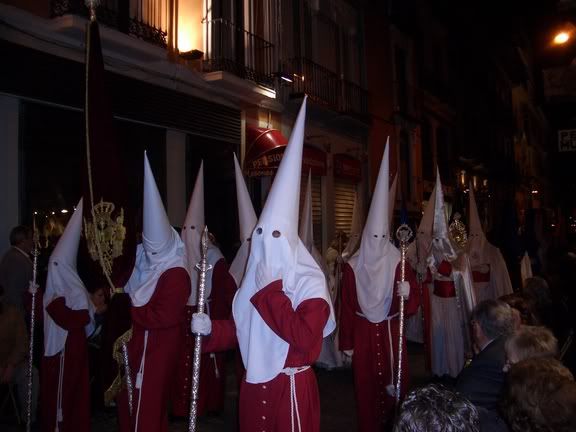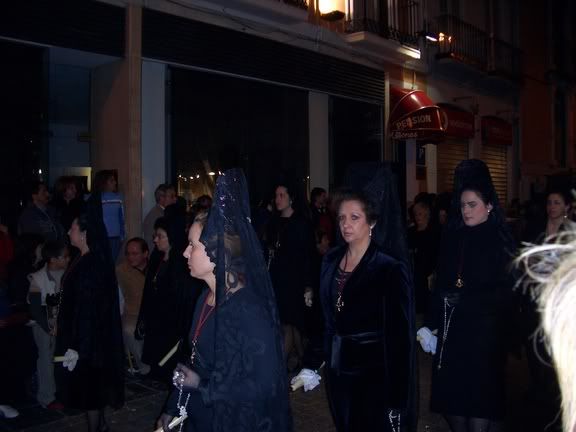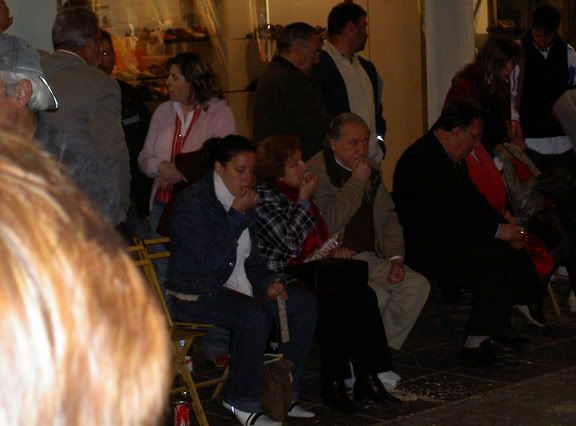While we are generally pretty good about reading up on our traveling destinations, we had no idea how to ‘track down’ the schedule of the processions. Apparently, each city and small town has its own processions, and they occur all throughout Andalucia during the Holy Week. We tried visiting numerous tourist information centers, but it seemed that all the other tourists and locals have gotten there before us, thus we were left with nothing but our luck. In the end, we saw all too many processions in whichever town we happen to be visiting, and sometimes the SAME procession in different parts of the same town.
During the Holy Week, most big cities in Andalucia: Malaga, Granada, Jaen, and especially Sevilla, are filled with people, locals and tourists alike, just waiting for the festival(s). Our most memorable encounter with the processions came one night, at the end of a day filled with adventurous and fun sightseeing in Granada. We noticed the traffic was cut off everywhere, and fold-up chairs miraculously appeared along side most of the streets, and people were stopping in huge droves. The most amazing part for me was, for the first time in three years after living in Spain, I could hear silence. In a country where public libraries are meeting grounds for loud teenagers and smoking librarians, at this given moment, they gathered IN SILENCE without a cue from anyone! I believe it was at this moment, that we found ‘the spot’ to watch these mysterious processions. Pushed up against the wall, trash cans, each other and other spectators, we eagerly stretched our necks (without really knowing which directions to stretch to), and waited impatiently for some spectacles which I knew nearly nothing about.
The silence continued while my patience slowly drained away. Looking around, I saw city residents who live on these streets leaning out of their balconies with babies, immediate and not so immediate families. Now, let us take one moment to explain what I understand is about to happen: apparently, each city has several ‘brotherhoods’, and they compete by parading a sculpture of the Virgin Mary on a float from one church or another. I suppose, the ‘winning’ team has the most attractive or ‘moving’ (emotional) display. Traditionally, this event has been so powerful for the locals because Andalucians view this ritual, not as representations of the Virgin Mary, but rather, a version of the true Mary. Somewhere in the midst of all this silence, a person (randomly) would be so moved that he or she would start sing/wail/cry out loud, and eventually be joined by others in the crowd. The sorrowful singing and wailing quality was said to have inspired Domenico Scarlatti to write some of his song-like sonatas. Knowing this, I continued to stand in silence, along with pushing neighbors, running children, and my long gone patience.
All of a sudden, the silence grew even more pronounced when from far away, I hear some soft rhythmic drum beats. In the midst of darkening skies, I could see some gigantic entity swaying left and right with dotting sparkles. Aside from the silence, what really drew me was the powerful scent of candles and incense. At this point, the giant entity was still too far for me to figure out what it was, but the sea of people before it was all decked out in amazing robes. Slowly, I could make out the first few groups were people dressed in colored robes and their heads covered in long cones, covering their heads and faces, with only the eye holes cut out so they could see. The atmosphere was solemn and the faces of spectators, serious. I understand that each group of brotherhood is represented by the color of their robe, so we patiently waited for each color to march by. The white robed group looked exactly like the Ku Klux Klan, complete with a shining + cross with some unfathomable symbol on the cross. I suppose I was conditioned by the white robes and what it signifies in another culture, to feel a slight shiver of fear and confusion when they marched by. Although I didn’t know what or if there was any correlation between this dress code of these brotherhoods and that of the KKK, the visual impact was the same.

After all robed brotherhoods have marched by us, we were visited by two rows of women clothed in black dresses and high heels, their heads adorned with a fan-like crown and their faces heavily made up. Nabí explained to me that they were the brides (widows) of Christ. I wonder who determines who get to be Christ´s widows, and how... why would anyone volunteer to be Christ's widows...

The uncanny silence, with its solem drum beats continued for a while, and the scent of candles and incense grew with my renewed interest. At last, the large swaying entity was near, the huge, I mean HUGE float was covered with long wax candles (dotting sparkles), and in the middle of the float was Virgin Mary, dressed in her finest, gold and cream robe, hands together, face streaked with ´tears´. I awaited for the first person to sing or cry, but the slight stir in the crowd was only caused by a few individuals who rushed up to touch the float and crossing themselves. The ‘swaying’ effect came from the people who were carrying the float from beneath. There was a metal ‘knocker’ in the front of the float, a ‘director’ knocks it once for it to stop and drop, and twice for it to pick up and continue.


I think it was at this point when Nabí pointed out to me that, in the midst of the procession, there was a vendor selling bags of sunflower seeds, and I don´t know why I haven´t noticed it until now, but everyone, the spectators, police, children, etc., I mean EVERYONE was eating them and spitting out the shells on the ground. Could this be the reason why it has been so silent? Or that nobody has come forth and sang anything yet? I don´t know what came over me, maybe it was the exhaustion from a long day, or the delirium from my pool of drained patience, or just the irony of the entire event, I started to laugh, and Nabí did, too. We couldn´t stop laughing for a few seconds, but quickly stifled ourselves for fear of blasphemy or offense to the locals. I found the irony between the ultimate respect and the spitting to be baffling, amusing and ridiculous all at the same time. They say the word ´aw-ful´ originated as a word describing the feeling for God, ´full of awes´, a feeling of mixture between respect and fear. Throughout the centuries, I suppose the word metamorphasized into its present meaning, the respect dropped out, and we are left with only its negative connotation.


No comments:
Post a Comment